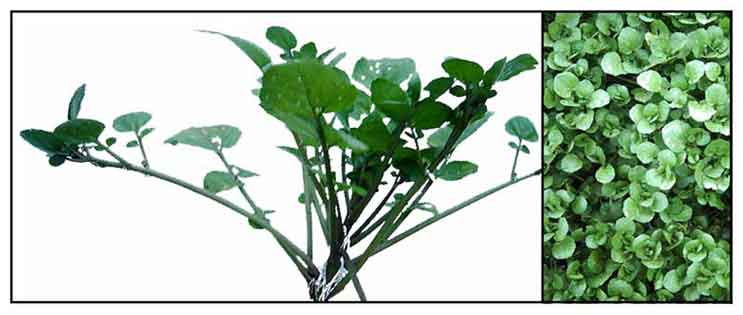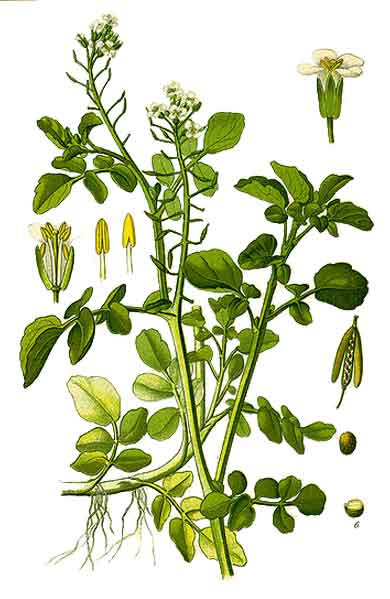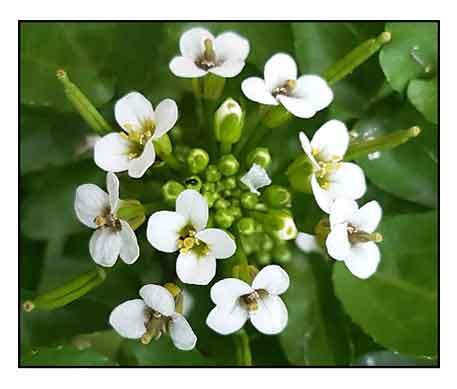|  Botany Botany
Tonghoy is a perennial floating aquatic plant, with very
branched creeping stems. The leaves are erect and pinnate; the upper
ones with 3 to 7 pinnules and a terminal one, the lower ones cut into
3 repand segments. Flowers are white, borne in short racemes. Petals
are longer than the sepals.
 Distribution Distribution
Abundant in shallow waters and small
streams in the Trinidad valley, Benguet areas, at altitudes of about
1,300 meters. The pods is 1.2 to 2.5 cm long, stalked and spreading,
or bent upward. Seeds are small and 2-seriate.
Constituents
• A good source of calcium;
a fair source of iron.
• Antiscorbutic; rich in vitamins A and C; fair in vitamin D.
• Contains an essential oil, the principal substance of which
is phenylpropionic acid nitrite.
• It also contains a glucoside, gluconastutiin.
• Contains specific indoles that help in disposing of excess estrogen;
heavy cooking destroys these indoles.
• Contains phenethyl isothiocyanate (PEITC), a compound known
for cancer-preventive properties. source
• Phytochemical screening yielded alkaloids, flavonoids, glycosides, terpenoids, saponins.
• Study of leaves for phenolic compounds yielded gallic acid derivatives, ferulic acid derivative, proanthocyanidin B1, p-coumaric acid derivative, apigenin, p-hydroxybenzoic acid, sinapic acid, p-coumaric acid, caftaric acid, quercetin-3-(cafferoyldiglucosdie)-7-glucoside, kaempferol-3-(caffeoyldiglucosdie)-7-rhamnoside, caffeoylmalic acid, coumaric acid derivative, (see study below) (19)
• GC-MS study of dried aerial parts for essential oil yielded 16 compounds. The dominant constituents were phytol 30.20%, 3-carene-10-acetyl-methyl 9.41%, beta-dumas-senon 7.42%, E-beta-lavonone 7.15%, naphthalene-2,1-dihydro-6,1,1-trimethyl 1.25%, 2-pentyl furan 1.32%, hexanal 1.06%. (see study below) (20)
• Nutrient analysis of raw watercress (100g): water 95.11 g, energy 11 kcal or 46 kj, protein 2.3 g, total lipid (fat) 0.1 g, ash 1.2 g, carbohydrate by difference 1.29 g, total dietary fiver 0.5 g, sugar 0.2 g, calcium 120 mg, iron 0.2 mg, magnesium 21 mg, phosphorus 60 mg, potassium 330 mg, sodium 41 mg, zinc 0.11 mg, copper 0.077 mg, manganese 0.244 mg, selenium 0.9 mg, vitamin C 43 mg, thiamin 0.09 mg, riboflavin 0.12 mg, niacin 0.2 mg, pantothenic acid 0.31 mg, vitamin B6 0.129 mg, total folate 9 µg, folic acid 0 µg, food folate 9 µg, total choline 9 mg, vitamin B12 0, vitamin A (RAE) 160 µg, beta carotene 1914 µg, vitamin A 3191 IU, lutein+zeaxanthin 5767 µg, vitamin E 1 mg, vitamin D 0 IU, vitamin K 250 µg, cholesterol 0, (24)
• Nutritional analysis of raw watercress (1 cup,chopped/34g)
yielded: (Proximates) water 32.34g, energy 4 Kcal, energy 16 kJ, protein 0.78g, ash 0.41g, carbohydrate 0.44g, total dietary fiber 0.2g, total sugars 0.07g; (Minerals) calcium 41mg, iron 0.07mg, magnesium 7 mg, phosphorus 20mg, potassium 112mg, sodium 14mg, zinc 0.04mg, copper 0.026mg, manganese 0.083mg, selenium 0.3µg; (vitamins) (water soluble vitamins) thiamin (B1) 0.031mg, riboflavin (B2) 0.041mg, niacin (B3) 0.068mg, pantothenic acid (B5) 0.105mg, pyridoxine (B6) 0.044mg, folate (B9) 3µg, folate food 3µg, folate DEF 3µg, choline 3.1mg, ascorbic acid (vit C) 14.6mg; (Fat soluble vitamins) vitamin A RAE 54 µg, vitamin A IU 1085IU, beta carotene 651µg, lutein+ zeaxanthine 1961 µg, alpha-tocopherol (vit E) 0.34mg, vitamin K (phylloguinone) 85µg. (USDA) (34)
• Nutrition analysis on lipids yielded: (Total saturated fatty acids 0.009g) palmitic acid 0.008g, stearic acid 0.001g; (Total monosaturated fatty acids) palmitoleic acid 0.001g, oleic acid 0.002g; (total polyunsaturated fatty acids) linoleic acid 0.004g, linolenic acid 0.008g. Flavonol content yielded kaempferol 7.8mg, myricetin 0.1mg, quercetin 10.2mg. (USDA) (34)
Properties
• A good source of calcium;
a fair source of iron.
• Improves appetite and bone health.
• Considered antiscorbutic, diuretic, expectorant, hypoglycemic,
odontalgic, purgative, stimulant, stomachic.
• Studies have suggested cardioprotective, hypolipidemic, antioxidant, hepatoprotective, platelet aggregating, antitubercular, antigenotoxic, nephroprotective, antibacterial, anti-inflammatory, anticancer, wound healing, neuroprotecitve, antidiabetic properties.
Parts utilized
Leaves.
 Uses Uses
Culinary
- Edible: leaves, seeds.
- Leaves, raw or cooked.
- Used as garnish and condiment.
- Seeds are powdered and used as mustard.
- Adding water to the powdered
seed activates the enzyme, myrosin. acting on the glycoside, sinigrin,
to produce a sulphur compound. Mixing hot water, vøinegar, or salt inhibits
the enzymatic reaction and produced a milder but bitter mustard. source
Folkloric
- Bruised leaves and juice, used as
a facial lotion to remove blotches, spots and blemishes.
- Used for tubercular patients.
- Used as expectorant, for asthma and coughs.
- Also used as a stimulant and aphrodisiac.
- Freshly expressed juice used for chest and kidney complaints, externally
for skin irritations and inflammations.
- Used as hair tonic, believed to promote hair growth.
- Poultice of leaves used for lymphatic swellings.
- In Iranian folk medicine, used for treatment of hypertension, hyperglycemia, and renal colic. (18) Mashed watercress mixed with honey is rubbed on the skin to treat cracks and dermal allergies. Mixed with milk, it is drunk for treat of bronchitis. Syrup made with 650 grams of watercress mixed with 1/2 kilo of powdered sugar, boiled or left in its own state to become a paste, is used for treatment of disorders of the liver and urinary tract. Watercress mixed with alcohol is massaged on the scalp for treatment of baldness. Also used for treatment of diabetes, gout and rheumatism. (28)
Others
- Nicotine solvent: Juice of plant used on tobacco as a nicotine solvent.
- Hamebuild: In Nigeria, Nasturtium officinale is one of 8 herbal ingredients of Hamebuild, a herbal blood tonic mixture. (see study below) (37)
- Sacred Herb: In Shamanic herbalism, watercress (Nasturtium officinale) is considered one of nine sacred herbs. (38)
Studies
• Cardioprotective
/ Hypolipidemic: Study of the hydroalcoholic extract
of N officinale on rats lowered total and LDL cholesterol and triglycerides
while raising serum HDL levels. Results shows a cardioprotective effect
and supports a basis for medical application. (2)
• Antioxidant / Lipid Benefits:
Study showed the extract of NO has notable scavenging activity against
DPPH radicals and potent reducing power. It reduced Total and LDL cholesterol
while increasing HDL levels. Results suggest the lipid effect could
be due to its antioxidative potential.(4)
• Hepatoprotective:
Study of the alcoholic extract of N officinale showed it significantly diminished acetaminophen-induced liver damage in a rat model. (6)
• Platelet Aggregating Effect:
Study of the the plant extracted with 50% ethanol showed a more potent platelet aggregating effect than the aqueous extract suggesting the platelet aggregation activating constituent may be more ethanol soluble than water soluble. (7)
• Anti-Tuberculosis Activity:
In a study evaluating nine plants used in Mexican traditional medicine to treat tuberculosis, Nasturtium officinale showed the best activity against sensitive Mycobacterium tuberculosis. (8)
• Antigenotoxicity:
Study evaluated the aqueous juice of watercress for genotoxicity and possible protective effect against damage induced by cyclophosphamide in vivo in male and female Swiss mice. Analysis of bladder histological changes suggest a probably protective effect. Watercress juice did not induce genetic damage, exhibiting a protective activity against CP. (11)
• Antioxidant:
Study investigated the antioxidant activity of N. officinale extract using various assays. Results showed potent reducing power in a ferric reducing antioxidant power assay, nitric oxide radicals, and hydrogen peroxide, as well as chelating ability on ferrous ions. (12)
• Hypoglycemic / Triglyceride Lowering:
Study of effect of feeding plant-mixed pelleted food in STZ-induced diabetic rats showed significant hypoglycemic effect and and significant lowering of triglyceride levels. (13)
• Glucosinolate Nasturtiin / Phenethyl Isothiocyanate (PEITC) / Anti-Cancer:
Watercress is the richest source of glucosinolate nasturtiin, which on hydrolysis produces phenethyl isothiocyanate (PEITC). PEITC is believed to be protective against cancers associated with tobacco specific carcinogens. PEITC was highest in leaves harvested at 40 days, producing 150% higher PEITC concentrations compared to leaves at transplant. (14)
• Wastewater Bioaccumulation of Heavy Metals:
Study showed Nasturtium officinale was able to accumulate both copper and zinc at upper levels, and nickel at low levels. (15)
• Anti-Inflammatory / Aerial Parts:
Study evaluated the anti-inflammatory activity of hydro-alcoholic extract of aerial parts of N. officinale in animal models of inflammation including carrageenan- and formalin-induced paw edema in rats. Acute toxicity study showed an LD50 of > 5 g/kbw. The extract significantly (p<0.001) inhibited carrageenan-induced paw edema and showed considerable activity (p<0.001) against formalin-evoked paw edema. Topical application reduced TPA-induced ear edema (p<0.05). Histopathology showed decreased swelling and tissue damage induced by carrageenan or TPA. Results showed potent anti-inflammatory activity in systemic and topical applications. (18)
• Antioxidant / Phenolic Profile: Study evaluated phenolic profile, antioxidant potential, and pigment contents of various extracts of wild watercress roots, stems, and leaves. Results showed that total phenolic compounds in all samples were higher in the methanolic extracts than corresponding aqueous extracts. Radical scavenging activity of ME was higher than aqueous extracts. (see constituents above) (19)
• Antibacterial on Food-Borne Bacteria / Antioxidant / Essential Oil: Study evaluated the antibacterial and antioxidant activities of N. officinale essential oil on some important food borne bacteria i.e., S. aureus, B. cereus, E. coli and Salmonella enteric. Results showed B. cereus had most susceptibility to the essential oil The antioxidant activity was less than BHT. Phytol (30.20%) had highest proportion in the EO.; least was megastigmatrienone 2 (0.18%). (see constituents above) (20)
• Nephroprotective / Vitamin E / Vancomycin-Induced Nephrotoxicity: Study evaluated the effect of Nasturtium officinale hydroalcohlic extract and vitamin E against VCM-induced nephrotoxicity in adult male Wistar rats. VCM significantly increased serum creatinine and urea levels, MDA levels, kidney weight, and reduced creatiinine clearance. Results showed NOE attenuated VCM induced nephrotoxicity. NOE and vitamin E pretreatment considerably attenuated all the changes. (21)
• Wound Healing: Study evaluated the efficacy of N. officinale as an adjuvant on the healing of traumatic ulcers on rat tongue dorsum. Punch induced l0.5 mm lesions were made to mimic traumatic ulcers. Treatment consisted of application of an oral solution containing 15% N. officinale on the lesions. Results showed promotion of wound healing on rats tongue dorsum with higher collagen deposits. (22)
• Hepatoprotective / Toxicity Study / Acetaminophen Toxicity: Study evaluated the effect of total extract and fractions of N. officinale for antihepatotoxic effect against acetaminophen induced toxicity in rats. LD50 value of petroleum ether fraction was more than 3823 mg/kg, while n-butyl alcohol and aqueous fractions and total extract were non-toxic up to 5734 mg/kg. Histopathological changes induced by acetaminphen were considerably reversed by the aqueous fraction and total extract. (23)
• Commission E: (1) Uses: Approved for catarrh of the respiratory tract. (2) Contratindications: Gastric and intestinal ulcers, inflammatory kidney diseases. No application for children under age four. (3) Side Effects:Rare gastrointestinal complains. (4) Pregnancy and lactation: Not recommended during pregnancy. No restrictions during lactation. (5) No reported interaction with other drugs. (25)
• Acute Oral Toxicity / Antioxidant / Leafy Stems: Study evaluated the in vivo toxicity and in vitro antioxidant effect of ethanolic extract from leafy stems of watercress. During acute oral toxicity evaluation in mice, strong agitation followed by immobility was observed at doses of 80 to 100 mg/kg. Several deaths were observed after three days. Results suggest the extract can be considered moderately toxic with LD50 in range of 50-500 mg/kbw. The extract was not able to exert an efficient antioxidant effect at low concentration in comparison with ascorbic acid, but it increased with higher doses. (26)
• Neuroprotective on Learning Ability: Study evaluated the neuroprotective effect of watercress extract on dexamethasone-induced neurodegeneration in Swiss albino mice. Testes included spatial memory and learning ability by Morris Water Maze, and density of parvalbumin (PV)-immunoreactive in the hippopotamus of the brain using immunohistocheistry. Results showed mice pre-treated with watercress extract were partially protected against dexamethasone- induced neurotoxicity. Watercress may have potential in preventing stress-induced physical and cognitive decline. (27)
• Ace Inhibitory Activity / Antihypertensive: Hypertension is a risk factor for cardiovascular disease. ACE (Angiotensin Converting Enzyme) inhibition can decrease vasoconstriction and decrease bradykinin degradation (vasodilation) by creating NO (nitric oxide). Study evaluated the in vitro ACE inhibitory activity of 70% ethanolic extract and fractions of watercress. An ethanol extract showed ACE inhibitory activity with IC50 of 19.05 µg/ml while an ethyl acetate fraction showed highest IC50 of 2.303 µg/ml. (29)
• Antidiabetic: Study evaluated the effect of N. officinale on plasma lipid and glucose levels in a diabetic rat model. Results showed significant reduction of plasma glucose. The greatest decrease (96%) was observed in the high dose (long-term group for NO) group which was significantly greater than the insulin group (49%) (p<0.001). There was not change observed in cholesterol and triglyceride levels and might have a negative effect on lipid profile. (30)
• Preventive Effect on Renal Stone Formation: Study evaluated the effects of hydrophilic extract of Nasturtium officinale on ethylene glycol-induced renal stone in male Wistar rats. Results showed no significant effects on calcium oxalate stone formation in rats, but in low dose, showed some preventive effect on renal stone formation. (31)
• Drug Interactions: Potential moderate drug interactions are of concern: (1) Chlorzoxazone (Parafon Forte, Paraflex): Watercress may decrease how quickly the body breaks down chlorzoxazone and increase its effects and side effects. (2) Watercress may decrease the body's excretion of lithium and may increase serum lithium levels and side effects. (3) Warfarin (Coumadin): Watercress contains large amounts of vitamin K which may decrease the anticoagulant effectiveness of warfarin. (32)
• Antioxidant / Leaves: Study evaluated the in vitro and in vivo antioxidative properties of aqueous and ethanolic extracts of leaf of N. officinale. The ethanolic extract was found to be the most active in total antioxidant activity, reducing power, DPPH radicals and superoxide anion radicals scavenging activities. It decreased lipid peroxidation in liver, brain, and kidney of rats. (33)
• Hepatoprotective / Gamma-Irradiation-Induced Toxicity in C57 Mice: Study investigated the protective effect of methanolic extract of N. officinale against gamma-radiation induced hepatotoxicity in terms of histopathological changes in male C57 mice. Pretreatment before γ-radiation significantly lowered the incidence of portal and periportal inflammation, together with slight reduction in liver cell necrosis, edema and congestion. The protection may be attributed to the presence of phenols and isothiocyanates in the extract which act as antioxidant and anti-inflammatory agents. (35)
• Antibacterial: In a study of Philippine medicinal plants for antibacterial activity against Staphylococcus aureus, Bacillus subtilis, Escherichia coli, and Pseudomonas aeruginosa, Nasturtium officinale was one of the plants that showed highly positive activity with mean zone of inhibition range of 15 to 30 mm. (see constituents above) (36)
• Hamebuild / Alleged Herbal Blood Tonic: Hamebuild is a Nigerian herbal blood tonic composed of 8 herbal ingredients: Urtica dioica 10%, Rumex acetose 15%, Polygonum aviculare 10%, Nasturtium officinale 10%, Eugenia tomentosa 10%, Taraxacum officinale 10%, Panax ginseng 10%, and Trigonella foecum (10%), with gamma globulin (10%) and water. Oral LD50 was greater than 5,000 mg/kg body weight. Study showed Hamebuild did not show significant influence on hematological, biochemical, or histopathological parameters in rats. The safety profile may explain its continued use in Nigeria. (37)
• Antifungal: Study evaluated the antifungal effect of watercress extract on growth of Fusarium solani, the causal agent of potato dry rot. All concentrations of the alcoholic extract significantly inhibited mycelia growth of Fusarium solani on PDA medium in a dose dependent manner. Results suggest a potential for the manufacture of natural fungicidal compounds. (39)
• Anti-Intestinal Bacteria:Study evaluated the effects of aqueous and alcoholic extracts of N. officinale on intestinal bacteria i.e., Escherichia coli and Enterococcus faecalis. Results showed the alcoholic extract had significant effect on both bacteria. The aqueous extract had little or close to zero effect on the bacteria. E. coli was more sensitive than E. faecalis. (40)
• Antimycobacterial Components: In a study focused on fractionation and identification of antimycobacterial principles in the plant species, 14 fractions were assayed, of which only fractions 3 to 5 showed good inhibitory activity against M. tuberculosis H37Rv. E-phytol was identified as the most abundant component. Antimycobacterial properties were attributed to E-phytol and palmitic acid. (41)
• Long-Term Safety Evaluation: Study evaluated the effects of water extract orally administered daily for 60 days at dose levels of 500 and 1000 mg/kbw in male Wistar rats. There were no changes in behavioral outcomes. Results suggest long term administration up to 1000 mg/kg in not likely to produce toxic effects. (42)
Availability
- Wild-crafted.
- Cultivated.
- Tinctures, herbal extracts in the cybermarket.
|


![]()

